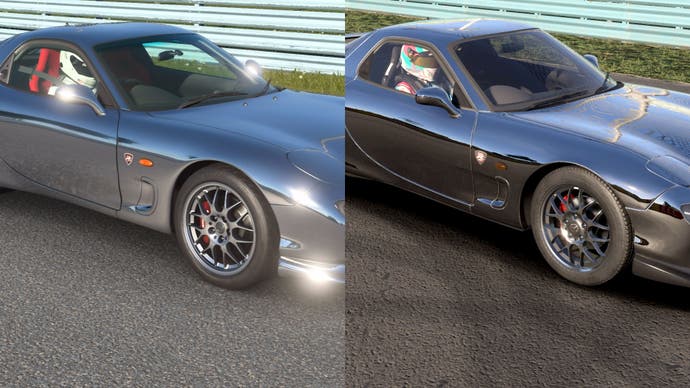Forza Motorsport vs Gran Turismo 7: the Digital Foundry tech breakdown
Two racing juggernauts compared in the most ambitious DF analysis yet.
This is Forza Motorsport vs Gran Turismo: The Revenge, as Turn 10 and Polyphony Digital's latest works return to Digital Foundry for a proper face-off six years after our first comparison between the two racing franchises. With the power of new generation consoles and years of meticulous work behind them, Forza Motorsport (2023) and Gran Turismo 7 promise a new level of visual fidelity. Can they deliver?
To find out, we'll directly compare these two titans of racing both in-game and around the track, on PlayStation 5 and Xbox Series X. We'll even bring real world locales into the mix this time.
It's not a surprise that fans of each series are heavily invested in this competition - and the comparisons are fascinating even for unaffiliated onlookers, despite the comparison being little more than an academic exercise with these games appearing on wholly different platforms.
After all, real-world auto manufacturers invest significant money into research and development in the pursuit of performance. Using race tracks such as the Nürburgring, cars are compared and validated based on their performance and specifications. This competitive spirit runs deep, fuelling engineers and designers alike and strengthening the firm's identity and focus. That's all despite the fact that these racing accolades tend to have minimal influence on the ownership experience - people tend to enjoy their cars even if they don't have the best lap times on a race track.
So it goes with Gran Turismo and Forza Motorsport. For decades, these franchises have competed, tackling problems in their own unique ways. It may not influence your enjoyment of either, but growing your understanding of how each developer tackles this subject is engaging. It's this difference in philosophy that I hope to present - by pouring over these two games, we're given a look into what it takes to capture the authentic appearance of motorsports in the virtual world.
As with real cars, there is nuance that must be considered in building such a comparison - and many of the decisions require explanation. Let's start by laying out some guidelines for our video capture and the resulting comparisons. We're looking at both games at 4K resolution and a 60Hz refresh rate with HDR disabled.
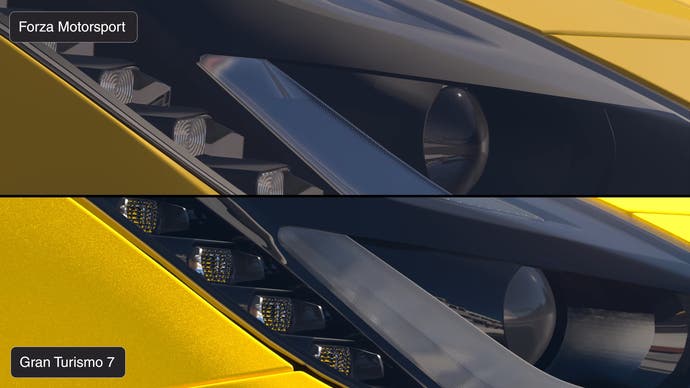
Forza Motorsport was captured on Xbox Series X with the high-resolution texture pack installed. In the accompanying video above and in stills reproduced in this article, I'll use each of the game's three modes, delineated with a clear label. This is to provide a wide view of what the game offers to players in terms of visuals. With Gran Turismo, quality mode was selected, but this applies to replays and photo mode rather than the racing action.
Each game features a vast number of tracks and vehicles, with only a subset of this content shared between the two games. Our comparison will focus on these common elements for obvious reasons, but hopefully it goes without saying that each game offers a much wider swathe of machinery and locales than we'll feature here.
I'd like to begin here on one of my favorite tracks - the jewel of Belgium, Circuit de Spa-Francorchamps. Situated within the province of Liege, this stunning track is known for its dramatic curves and breathtaking scenery. The real-world track has been updated since its inclusion in Gran Turismo and Forza but there's still a lot to take in and appreciate.
Let's start by taking a test drive around the course in each title in the beautiful Toyota GR Supra RZ in a third-person perspective, with the time of day set to early morning, closely matched between the two games with comparable sun position. Before we even talk about the differences, though, I think it's worth appreciating just how beautiful both games look in motion. The crisp blue skies and deep green forests are stunning.
There are differences to note here that persist throughout each game. Firstly, in terms of the general tone-mapping and representation of colour, Gran Turismo aims for what I'd describe as photo realism, with exceptionally deep, eye-catching color that captures the look of a perfect day. Forza, however, takes a more grounded approach with a gray-tinged, dirtier tone that is realistic in its own right - it's part of the signature Forza look and it persists in the latest game. This is a matter of preference, but it helps explain why the two games often appear rather different when side-by-side.
Another difference is that Forza uses ray-traced reflections while Gran Turismo relies on cubemaps - with a gantry overhead flashing onto the car body as we complete the lap. In Forza, the reflection lacks the bold white colour of the sign above, while the whole back window of the car lights up with it in GT7. If we pull up to the sign and stop in Forza, the reflection is perfectly sharp - so what might be happening is that the game can't denoise and reconstruct the reflection fast enough at high speed, resulting in the break-up in the image.
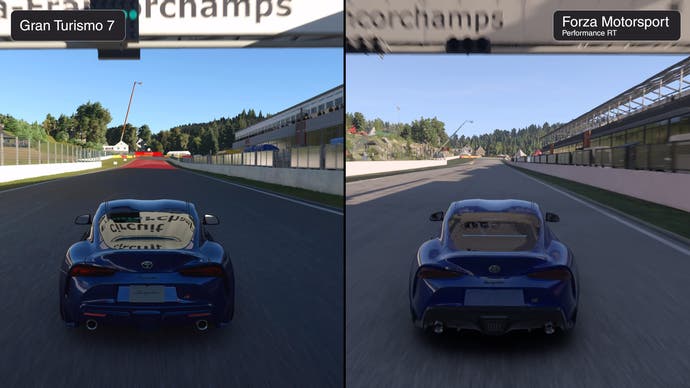

This doesn't happen with cube maps, however, which Forza also uses. In fact, looking closely at the car from another angle reveals Turn 10 layers RT reflections (for close objects) and cubemaps (for more distant objects) on reflective surfaces. The benefit of RT in Forza lies in the fact that you can see other cars reflecting on one another while driving - something GT7 cannot offer.
Switching to a first-person cockpit camera for a second run around the track, we get our first look at the cars' interiors - and my first impression is that Forza has made significant progress with this new entry. There is a greater distinction between the various materials in the cabin, while ray-traced ambient occlusion (RTAO) helps solve the occlusion issues that plagued prior installments. GT7 has its own solution to occlusion that is not ray-traced but is still effective nonetheless.
Both cars simulate reflections on the windshield glass and both boast working gauges too. That said, there are more working gauges in general in GT7, and the Toyota badge on the steering wheel is also more reflective - which, according to real-world footage, more accurate to the real car. There are subtle differences in how the materials interact with light and in their shading as well - but both look excellent in this example. Furthermore, motion blur is disabled when in cockpit view in Forza, while it's retained in GT.

Of course, a more stark difference in this particular comparison is that GT7 uses the right-hand drive Japanese domestic version of the Supra, while Forza features the American left-hand drive model, as you'd expect given the setting of the two studios.
Looking at the exterior of the car in each game reveals more differences, with the 'deep blue metallic' paint chosen in each title appearing quite different on-screen. Looking at a car in gameplay mode in the factory red colour instead, there's still a stark difference in how light interacts with each car's clear coat. Paint simulation is exceptionally difficult and, while Forza has improved since the last game, I think GT7 produces a more natural, pleasing result. GT7 also has excellent baked ambient occlusion which Forza finally matches, thanks to RTAO available in the performance RT and quality modes. All the little crevices are properly shadowed on each car. At this angle, in the shadows, GT's richness shines again but it's interesting how we can see the same structure reflected in the paint.
Before we zoom in closer, though, there's another nitpick I want to mention in regards to Forza: wheel spin. When accelerating, Forza relies on a texture trick, basically swapping the 3D wheel for a blurred texture. This is how Forza has always handled this feature, but it sticks out even more thanks to an issue with wheels seemingly seizing up while accelerating. GT7, in comparison, seems to apply proper per-pixel motion blur to the rotation of the wheel mesh itself so it looks more realistic in motion.
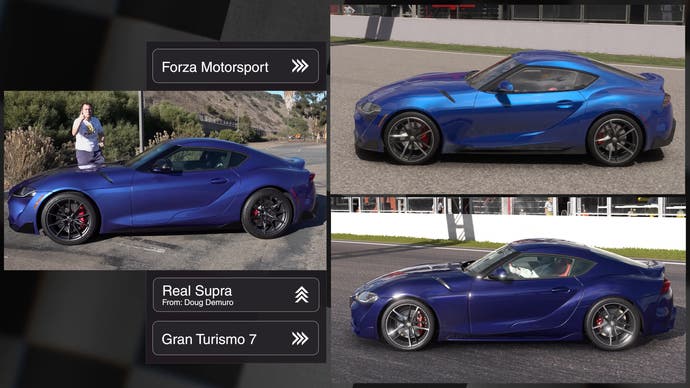

If we switch to each game's photo mode, we get a 30fps result in both cases with RT reflections enabled in Gran Turismo 7 - and this seems like a fair choice for examining some micro detail. Headlight assemblies are a great place to start, with various transparent materials and intricate details. Gran Turismo has always excelled at reproducing this, and GT7 is no exception with a more realistic depiction than Forza - especially in terms of how paint, plastic, glass and metal are reproduced.
It's a similar story at the back of the car, where a shiny black material is used. This produces quite bright reflections in Forza, with GT producing a darker and more accurate result. Still, compared to Forza 7, I think there is a clear boost in quality on the Forza side this time around. The paint shaders have improved for sure, while RT helps bring the two games closer together.
Let's park the vehicle comparison for a bit and take a look at the track of Spa itself. Neither version is consistent with the venue's recent renovations, which saw the addition of a grandstand after La Source and a widening of the run-off around Raidillon on safety grounds, but both feature impressive trees and foliage surrounding the track with proper shadows. The level of detail is excellent, though differences do exist even with a matched time of day determined by comparing the angle of the sun and the location of shadows.
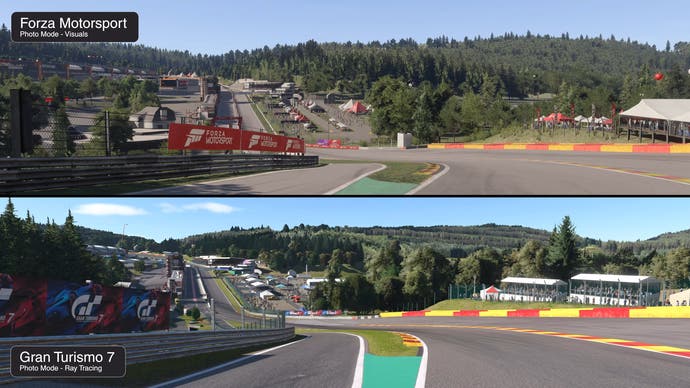

Viewing the side of the track, there are suitably packed crowds that vary depending on the race type in both cases - with fewer fans attending for time trials and more for a race. Forza features much better overall crowd animation, with every NPC waving their arms and moving around in a convincing fashion, while GT's fans are less effusive with their praise and tend to wander around more - and they sport shadows, unlike in Forza.
If we turn our gaze to the track surface and grass, textures appear sharper in GT currently - while the texture pack is installed on Xbox, I get the feeling that it's still not working correctly. Forza does use some sort of displacement mapping on certain surfaces, such as grass, to give it extra depth. However, the low-res texture and reduced grass blades compared to GT7 wind up looking worse to my eyes and the grass in GT is simply fuller throughout.
Another interesting thing that GT does is simulate lighting on rough surfaces. As we pan around in Forza, the track appears evenly lit, while GT boasts more subtle depictions of lighting across the tarmac surface, simulating rough reflections and lending it an extra hint of realism.

One Forza advantage worth mentioning are the tyre barriers, which are more detailed with separate geometry for the stacked tyres and the thinner barrier keeping them in place. They're more interactive in Forza too, spilling out and covering your car if you happen to drive into them at full whack.
With regard to trackside detail, though, I find that both games do an awesome job on this track with largely subtle details that may be down to when the track was scanned - although some elements like drainage covers seem more accurately rendered in Gran Turismo than in Forza. Overall, GT has a brighter, crisper tone - like a cool autumn day while Forza feels like a hot, hazy summer afternoon in comparison, but both are extremely detailed overall and both feel suitably realistic in terms of rendering features.
While Forza has superior 3D tree rendering, I'd argue Polyphony Digital seems to have more accurately captured the distant shape of the trees behind the track - and more frequently gets the species of tree right too, where Forza isn't always accurate. Instead, Forza seems to use its trees to block off views of distant scenery, which is a shame for a track with plenty of elevation changes like Spa. GT isn't a slavish facsimile of real life in terms of its tree placement, mind you, but there's a marked focus on accuracy here versus density in Forza.
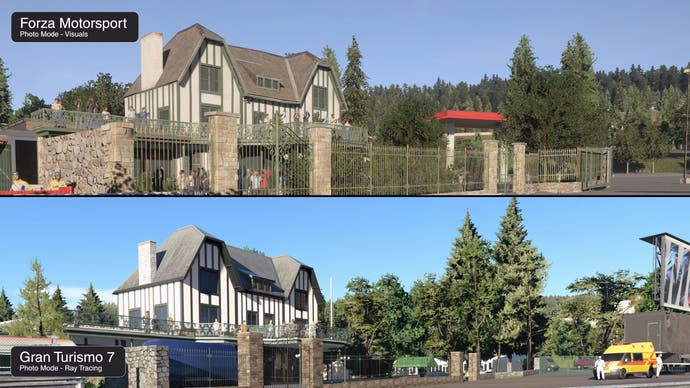
As the sun sets, we're given a different look at the track, demonstrating the visually dynamism of each game. Each car on-track projects beautiful dynamic lighting that varies based on the make and model, with modern LED-equipped cars producing brighter, cooler lights versus older cars with incandescent bulbs.
The most obvious difference between the two games stems from light intensity. GT tries to simulate the extreme ends of dynamic range, while Forza takes a more even-handed approach to lighting. Car materials also react differently in this dark environment, with the Forza car paint taking on more of a matte finish, for instance, while GT retains its shine.
If we jump into the cockpit, I think both games also do an excellent job simulating external lights playing off the dashboard. When a driver pulls up behind you, for instance, their lights will shine into the cockpit project light and shadow in real-time.

I also took the Corvette ZR1 for a spin in the rain at night, which looks extremely impressive in both cases. Forza's primary advantage here stems from its use of droplets on the camera, a tried-and-tested technique that has impressed for years. GT, in contrast, has rain particles that are influenced by dynamic lights as you drive. In comparison, Forza's rain droplets are visible even when the scene is dark - which wouldn't the case in real life.
Forza and Gran Turismo also handle reflections very differently on the ground, with GT mostly using planar reflections with screen space elements but Forza relying entirely on screen-space reflections - which means all reflections disappear when their source is occluded.
I'd also like to mention the dynamic time of day and dynamic weather featured in both games. For the first time in a Forza game, the time of day in Motorsport is dynamic across every single track, with shifting shadows and inclement weather - while GT7 has a similar feature, but weather and time-of-day changes are limited to only a portion of the game's tracks. Despite this, I think GT's cloud formations and lighting are more dramatic than Forza when looking at a 24-hour timelapse at Spa.

Moving to a dusky scene at Watkins Glen, a beautiful circuit based in New York state founded circa 1956, more differences are evident. A lap here demonstrates the striking beauty of Gran Turismo's sky system; Polyphony poured a lot of time into simulating the sky dome and it really shows here. I was also struck by the dynamic range visible in our Mazda MX-5's tail-lights - that intense red glow is captivating. Forza, on the other hand, takes a different approach to Watkins, with spotlights set up around the course to minimise dark areas. That makes for a more realistic - if less dramatic - drive.
Changing to the BMW E46 M3 dressed in silver and racing at dawn, there's a stark difference between how light is depicted between Forza and GT. I think this is why some people so strongly prefer one or the other - they're aiming for very different things. If we look at Forza running in its quality mode, we lose the ray tracing from Performance RT but resolution jumps from around 1584p to a full 2160p (native 4K).
With this setting engaged, the lines on the car become much cleaner and more defined. The cars featured here aren't identical - the 2005 model in Forza features a sat nav and other small feature additions versus the 2003 model in Gran Turismo, but both cockpits and exteriors look great.

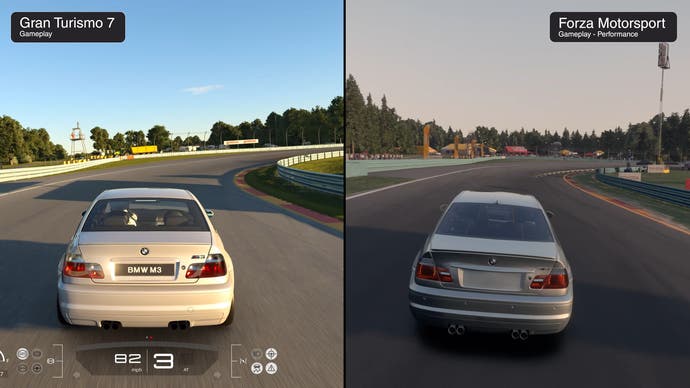
If we re-enable the performanec RT mode for Forza, you get better shadowing under the car, but panel gaps are less visible than expected despite the RTAO, with more obvious gaps in GT7. I also prefer the material used on the wheels in the GT edition - they appear more metallic and accurate to the real car.
Up close, both cars look pretty good. The rear exhaust pipes seem to fit better with the car on the GT side, though, which is odd given the use of RTAO. The wheel size also seems strangely different, and zooming in reveals more visible edges around the BMW logo in the centre on GT but more wheel arch geometry in Forza.
In front, the light fixtures appear similar, though GT's 2003 car lacks the headlight washer option. I particularly like how that small incandescent bulb looks within its housing - very realistic. GT also has an advantage when it comes to the taillights - an area that I feel Turn 10 should focus on given that you're looking at these lights constantly when driving with a chase cam.


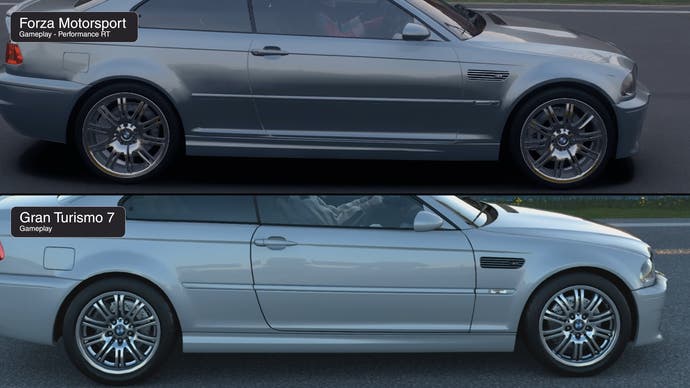
Let's shift the mood and talk damage before we jet off to our next track. Forza has a more advanced damage model and simulates dirty cars exceptionally well. This isn't Burnout or BeamNG.drive, so cars won't break apart and don't feature proper soft body physics, but Forza does boast an advanced paint layered system and realistic crumbling that produces impressive results.
Driving around the Glen like a fool and slamming into walls at full speed, scraping other cars and even flipping the car entirely feels silly, but it is pretty fun in Forza. Things are altogether more sedate in GT7, with more restrained paint and panel damage, and that difference in wear is visible even after a single lap.
Forza also makes it a lot easier to get into crashes during single-player racing, with AI that is far more likely to crash into you while you're stalled on track or run you off the road at a corner - while GT7's AI was more cautious and reactive, slowing down to try to avoid collisions. I guess you could argue that either approach is more realistic, with Forza's perhaps better imitating online racing lobbies and GT's a better analogue of real-world racing.
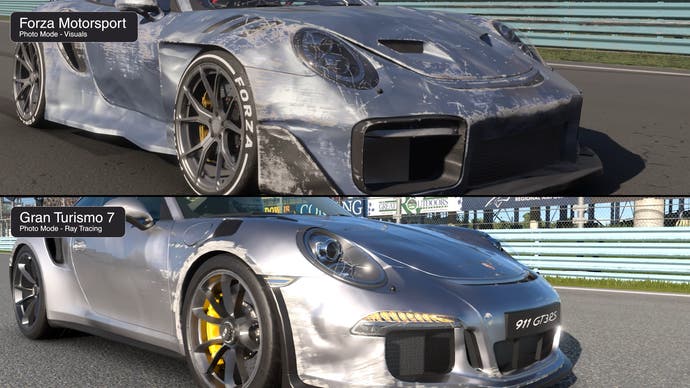
You'll also notice differences in how cars look when doing donuts - on grass, GT produces more stones and grass blades, even depositing them onto nearby asphalt, but on dirt, Forza kicks up more alpha particles like dust clouds. The game also does a better job with things like tyre tracks and smoke on the pavement and the cars themselves show more dirt after racing.
Our next location is Laguna Seca, one of the world's most legendary race tracks and a mainstay for racing video games for decades. In GT, Polyphony opted to model the track based on its appearance early in the season, when there's still greenery visible and the track is in pristine shape; Forza, however, seems to represent the track later in the season, when it's dirty, dusty and brown. Both, however, do a good job with the surroundings. The dramatic clouds and the detail in the landscape work beautifully.
Comparing against the real track on Google Earth, both tracks mimic the real course, with GT7 again boasting more accurate tree placement, while Forza Motorsport has an arguably more detailed rendering of the sky, trackside objects and distant hills. The impression I get is that, while GT perhaps more closely matches the placement of things in the real track, Forza's increased density is pretty striking.

Our final stop is the Nürburgring. Forza is currently missing the long Nordschleife course, something I used six years ago to compare Forza 7 with GT Sport, but we can use the smaller GP circuit instead to test out how these games handle rain.
Each title has a different approach here, with Forza's being centred around creating an eye-catching, high-intensity experience. It looks great, with reflective tarmac, droplets forming on the virtual camera lens and particles generated from the wheels as you plow through the storm. There's even thick fog when set to the highest rain levels. Couple that with the dynamic cloud simulation and it looks pretty stunning. The main nitpick I'd raise lies in the tarmac - it's too even and too reflective. (It also disappears when occluded due to the nature of SSR.)
Gran Turismo takes a very different - less flashy, more realistic - approach. There are no lens effects, the track isn't a mirror and particles from other vehicles are limited. This makes for a less intense look in motion, but the game's repersentation of a wet tarmac surface is impressively realistic. It features highly diffuse specular reflections with mirror-like reflections appearing within puddles where water collects. Grassy areas also become increasing muddy as water levels rise, a step not replicated in Forza.
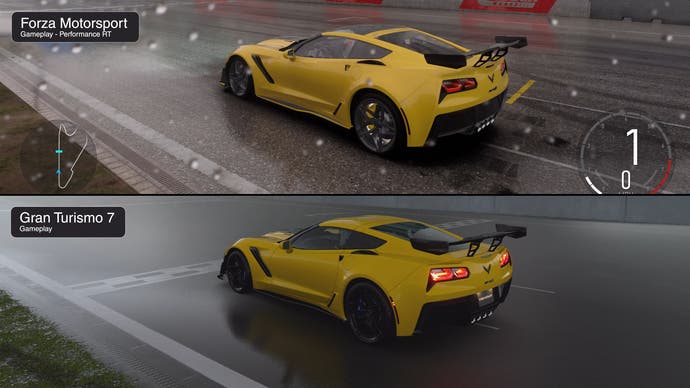
The sky lighting in particular plays a significant role in making GT look realistic during the rain. Plus, brake and headlights shine brightly across the track surface, while car reflections are more diffuse.
Judging the winner of this comparison is difficult, as despite GT7's realism, Forza's flashiness really does pay off at high speed, where the water spray from opposing cars and the droplets on the game camera accentuate that feeling of driving through a rain storm. GT7's tarmac looks great, but the spray effects are less convincing... and more importantly, a full grid of racers causes the frame-rate to dip. This doesn't happen in Forza, despite the game being able to support three more cars on track at once.
Thinking of frame-rate, though, one thing I found interesting is that both games have alternate frame-rate modes. Forza offers a 30fps visuals mode, versus the locked 60fps of performance and performance RT, while GT7 offers 120Hz output at 1080p. It'd be interesting to see both games offer what the other does - a 30fps mode in GT could allow for RT while racing, whereas a 120fps mode in Forza could boost fluidity at the expense of resolution.
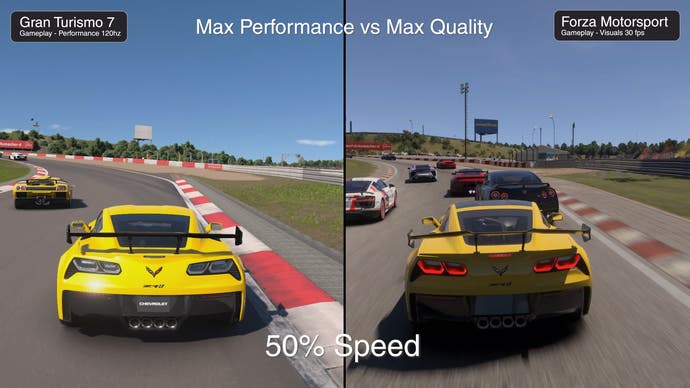
When I step back, though, it occurred to me that Forza Motorsport in many ways resembles Gran Turismo sport: it's a new starting point for the series. While it does carry with it some baggage from the past, and the downgrade from earlier footage is disappointing, I think the core of the game is solid and it feels great to play.
In comparison, GT7 is built on GT Sport and it shows - it's a more mature experience, much like Forza 7 was more evolved than GT Sport. It's clear that both will continue to receive support going forward as well, with GT7 recently receiving the 'Spec II' upgrade in addition to PSVR2 support earlier this year. Forza is also receiving updates and features and we'll see where it's at in a couple of years.
Each game has its advantages too - while GT7 offers beautiful dynamic weather and time-of-day changes with dramatic skies, this is only available on some of the tracks, whereas the Forza solution allows for these elements on every track in the game.
I'm hesitant to give a final opinion but, in the end, I need to do so. I think both games have a lot to offer, especially on the visual front, and my opinion should have no impact on your enjoyment of either or both games.
After speaking with the entire DF team and based on the experiences of playing both games, we've decided that Gran Turismo 7 gets the nod as the more visually striking game of the two. This isn't even about hardware performance - GT7 could run on Series X hardware just as Forza could run on a PS5.
Whichever you play, however, there's little doubt that both teams have poured their souls into creating these games. Creating something at this level and this quality is exceptionally difficult - even the smallest error is picked up on by the hardcore. Over the last two weeks, pulling these games apart, my respect and admiration for both Polyphony and Turn 10 has only increased and I cannot wait to see where they go next.
